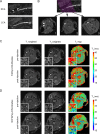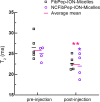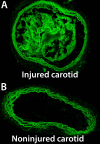Evaluation of iron oxide nanoparticle micelles for magnetic particle imaging (MPI) of thrombosis
- PMID: 25746677
- PMCID: PMC4352001
- DOI: 10.1371/journal.pone.0119257
Evaluation of iron oxide nanoparticle micelles for magnetic particle imaging (MPI) of thrombosis
Abstract
Magnetic particle imaging (MPI) is an emerging medical imaging modality that directly visualizes magnetic particles in a hot-spot like fashion. We recently developed an iron oxide nanoparticle-micelle (ION-Micelle) platform that allows highly sensitive MPI. The goal of this study was to assess the potential of the ION-Micelles for MPI-based detection of thrombi. To this aim, an in vivo carotid artery thrombosis mouse model was employed and ex vivo magnetic particle spectrometer (MPS) measurements of the carotid arteries were performed. In addition, we studied the effect of functionalization of the ION-Micelle nanoplatform with fibrin-binding peptides (FibPeps) with respect to nanoparticle thrombus uptake and hence thrombus detection. In vivo quantitative MR imaging pre- and post-ION-Micelle injection was performed as reference for visualization of ION-micelle uptake. ION-Micelles significantly decreased T2 values in the thrombi with respect to pre-injection T2 values (p < 0.01) and significantly increased ex vivo MPS thrombus signal with respect to the noninjured, contralateral carotid (p < 0.01). Functionalization of the ION-Micelles with the FibPep peptides did not result in an increased MPS thrombus signal with respect to the non-fibrin binding ION-Micelles. The lack of a significant increased thrombus uptake for the FibPep-ION-Micelles indicates that (non-fibrin-specific) entrapment of nanoparticles in the mesh-like thrombi is the key contributor to thrombus nanoparticle uptake. Therefore, (nontargeted) ION-Micelles might be of value for noninvasive MPI-based diagnosis, characterization and treatment monitoring of thrombosis.
Conflict of interest statement
Figures






Similar articles
-
Iron oxide nanoparticle-micelles (ION-micelles) for sensitive (molecular) magnetic particle imaging and magnetic resonance imaging.PLoS One. 2013;8(2):e57335. doi: 10.1371/journal.pone.0057335. Epub 2013 Feb 20. PLoS One. 2013. PMID: 23437371 Free PMC article.
-
Evaluation of 111In-labeled EPep and FibPep as tracers for fibrin SPECT imaging.Mol Pharm. 2013 Nov 4;10(11):4309-21. doi: 10.1021/mp400406x. Epub 2013 Oct 23. Mol Pharm. 2013. PMID: 24099178
-
Hybrid, metal oxide-peptide amphiphile micelles for molecular magnetic resonance imaging of atherosclerosis.J Nanobiotechnology. 2018 Nov 15;16(1):92. doi: 10.1186/s12951-018-0420-8. J Nanobiotechnology. 2018. PMID: 30442135 Free PMC article.
-
Chronic thrombus detection with in vivo magnetic resonance imaging and a fibrin-targeted contrast agent.Circulation. 2005 Sep 13;112(11):1594-600. doi: 10.1161/CIRCULATIONAHA.104.522110. Epub 2005 Sep 6. Circulation. 2005. PMID: 16145001
-
Magnetic Particle Imaging: An Emerging Modality with Prospects in Diagnosis, Targeting and Therapy of Cancer.Cancers (Basel). 2021 Oct 21;13(21):5285. doi: 10.3390/cancers13215285. Cancers (Basel). 2021. PMID: 34771448 Free PMC article. Review.
Cited by
-
Coagulation System Activation for Targeting of COVID-19: Insights into Anticoagulants, Vaccine-Loaded Nanoparticles, and Hypercoagulability in COVID-19 Vaccines.Viruses. 2022 Jan 24;14(2):228. doi: 10.3390/v14020228. Viruses. 2022. PMID: 35215822 Free PMC article. Review.
-
Magnetic Nanoparticles as MRI Contrast Agents.Top Curr Chem (Cham). 2020 May 7;378(3):40. doi: 10.1007/s41061-020-00302-w. Top Curr Chem (Cham). 2020. PMID: 32382832 Free PMC article. Review.
-
Evaluation of Iron Oxide Nanoparticles Toxicity on Liver Cells of BALB/c Rats.Iran Red Crescent Med J. 2016 Jan 30;18(1):e28939. doi: 10.5812/ircmj.28939. eCollection 2016 Jan. Iran Red Crescent Med J. 2016. PMID: 26889399 Free PMC article.
-
A Review of Magnetic Particle Imaging and Perspectives on Neuroimaging.AJNR Am J Neuroradiol. 2019 Feb;40(2):206-212. doi: 10.3174/ajnr.A5896. Epub 2019 Jan 17. AJNR Am J Neuroradiol. 2019. PMID: 30655254 Free PMC article. Review.
-
Blood clot detection using magnetic nanoparticles.AIP Adv. 2017 Feb 16;7(5):056723. doi: 10.1063/1.4977073. eCollection 2017 May. AIP Adv. 2017. PMID: 28289550 Free PMC article.
References
-
- Srichai MB, Junor C, Rodriguez LL, Stillman AE, Grimm RA, Lieber ML, et al. Clinical, imaging, and pathological characteristics of left ventricular thrombus: A comparison of contrast-enhanced magnetic resonance imaging, transthoracic echocardiography, and transesophageal echocardiography with surgical or pathological validation. Am Heart J. 2006;152: 75–84. 10.1016/j.ahj.2005.08.021 - DOI - PubMed
Publication types
MeSH terms
Substances
LinkOut - more resources
Full Text Sources
Other Literature Sources
Medical

